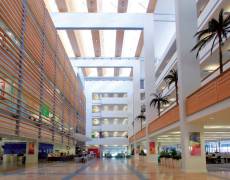May 30, 2013
UK public sector leading the way in procurement and sustainable building
Over the last few years, the UK Government has grown increasingly interested in finding ways of making its £30 billion property portfolio more efficient. Both the last Labour government and the current Coalition administration have been driven by the opportunities offered them with the advent of new technology, new ways of working and new procurement models. They’ve pursued these issues to cut costs by reducing and changing the way property is designed and managed but have also found how that can also help to establish best practice in sustainable building. What is increasingly apparent, especially given recent news from the Major Projects Authority about cost savings in procurement is that the public sector is now leading the way as models of good practice.
When it comes to the massive public sector estate, while the principle driver has been budgetary, there is a whole raft of welcome side effects in terms of the estate’s environmental performance. This can be very significant indeed given that commercial buildings account for as much half of the UK’s total emissions, according to the Building Research Establishment. Over the past few years, the UK has set ambitious targets for what it is looking to achieve in getting this figure down. Recent changes to, and greater awareness of, key legislation and guidance such as the development of the BREEAM assessment method, SKA ratings, the Carbon Reduction Commitment, the Energy Performance of Buildings Directive (EPBD) and Energy Performance Certificates (EPCs) have served to highlight the opportunities and the links that exist between the bottom line and sustainable building.
In part this is happening organically. As the public sector reshapes itself, so too do its buildings. Last year the National Audit office produced a report into the efficiency of central Government property and found that some departments had occupancy rates as low as 40 per cent. So there is a clear opportunity to do things differently to keep costs down and improve the environmental performance of these buildings, not least in divesting them. Fortunately the NAO was able to note the progress being made by the Government Property Unit in addressing these issues but its report also highlighted the need for an extensive review of property strategies across the public sector.
One of the most exciting developments when it comes to new buildings is Government Soft Landings, a project which aims to improve public sector construction projects and identify efficiencies at every level of the design, construction and management of buildings. Its information based approach is typified by the alignment of building design with asset management to ensure that the objectives of the building at its inception are carried through to its operation by engaging with facilities managers and end users at an early stage and monitoring the building’s use throughout its life. Put simply, what gets measured gets managed.
By focussing on the life cycle of the building in this way, there is an inbuilt degree of flexibility that allows it to cope with changes to the culture of the organisation that inhabits it. One of the most immediate challenges may be to meet the growing interest being shown by public sector workers in the principle of flexible working. It’s fair to say that their taste for this was whetted during the Olympics when many London based staff were allowed to work from home.
More than half of workers in the South East now say they want to work flexibly on a more regular basis according to a survey by Vodafone, which also found that almost a quarter not only claimed that they had changed their normal working arrangements during the Olympics but that had achieved better productivity as a result. Another survey from the Institute of Leadership and Management (ILM) found that 43 percent of companies that ran flexible working schemes during the games planned to continue them.
Their positive approach is set to have a profound effect not only on the way we work but also on the market for commercial property and the design and management of workplaces across all sectors. Research from Citrix of 1,900 senior IT decision-makers across 19 countries was published at the end of September and produced some remarkable findings including:
- By 2020 organisations are set to reduce office space by almost a fifth.
- The workplace will provide just seven desks for every ten office workers..
- A third of people will no longer work from their traditional office.
- A quarter of organisations have already adopted new ways of working. By the middle of 2014, that will be 80 percent.
Of course, as work changes so too will the places we need to do it and the infrastructure needed to get us there. One thing that will not happen is the vaunted death of the office. While we are potentially freed by technology to do things in new ways, humans are essentially the same creatures that hunted and gathered as communities on the plains of sub-Saharan Africa thousands of years ago. They have the same needs for company, the structuring of time, a sense of belonging and security. The office, of course, is just one of the ways we meet these needs. So while offices will undoubtedly continue to get leaner, supporting more people from the same or less space, their essential relationship with people will remain. They will still provide the glue that binds people to the organisation and to each other.
The bonds will be looser however. We are now past the point where it is possible to conceive a world in which many organisations micromanage the timing, location and nature of people’s work. Human Resources magazine recently polled senior HR professionals on their ideas of what a head office of the future would look like, and found that by 2014 around 23 per cent of respondents hope for a more decentralised approach to head office power and 14 per cent hope for a ‘virtual’ head office, staffed by flexible workers, homeworkers or global workers. No wonder that, according to UK Government statistics, around a quarter of staff already work from home at least some of the time. The need here is for a shift away from physical infrastructure to technological infrastructure to support staff as they work in different locations. People should never feel disconnected from the organisation and the ability to book space quickly, easily and remotely is essential.
These changes will not only have a profound effect on the people who work in them but also on the environmental performance of both the organisation and the building it calls home. For most organisations the total operating cost of their property currently runs at between 10 and 20 per cent of their annual operating costs. A significant fall in the scale of the building they inhabit will have a profound effect on their operating costs but will also offer a number of important environmental benefits not least in terms of lower energy consumption, fewer raw materials and a significant reduction in the number of journeys made by employees. Cost savings and environmental benefits go hand in glove.
__________________________________________________
 Paul Statham is the managing director of Condeco, a global workplace management software and systems provider based in London. www.condecosoftware.com
Paul Statham is the managing director of Condeco, a global workplace management software and systems provider based in London. www.condecosoftware.com















May 30, 2013 @ 9:06 pm
Paul you have hit a number of key points on public sector estate. We should always remember that the “greenest” buildings are those that are never procured or built. There are some good public technology initiatives being progressed like PSN which will support integrated agile working, but it would be good to see less silo mentality in public sector and more focus on determining holistic “total public place” requirements.